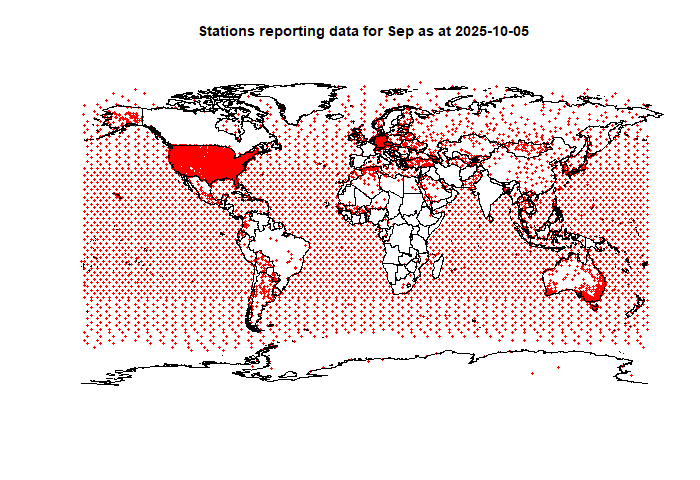The TempLS FEM anomaly (1961-90 base) was 1.04°C in September, up from 0.989°C in August. It was the third warmest September in the record, behind 2023 and 2024.
Here is the temperature map, using the FEM-based map of anomalies. Use the arrows to see different 2D projections.
As always, the 3D globe map gives better detail. There are more graphs and a station map in the ongoing report which is updated daily.
And here is the map of stations reporting:

This post is part of a series that has now run since 2011. The TempLS mesh data is reported here, and the recent history of monthly readings is here. Unadjusted GHCN is normally used, but if you click the TempLS button there, it will show data with adjusted, and also with different integration methods. There is an interactive graph using 1981-2010 base period here which you can use to show different periods, or compare with other indices. There is a general guide to TempLS here.
The reporting cycle starts with the TempLS report, usually about the 8th of the month. Then when the GISS result comes out, usually about the 15th, I discuss it and compare with TempLS. The TempLS graph uses the FEM solution on a regular near equal area grid on the sphere ; the residuals are displayed more directly using a triangular grid in a WebGL plot here.
A list of earlier monthly reports of each series in date order is here:












Just two areas below average, lol. The world keeps heating up. How much longer until WUWT and the other 'skeptic' blogs face the facts? How much higher does it need to go?
ReplyDelete"Relax, you climate cultists! New York was also completely submerged in the Cretaceous! This is business as usual!"
DeleteIt took me a few moments to realize that was tongue-in-cheek, Eclang. Thanks for the quotations marks!
ReplyDeleteGlad you understood :)
Delete